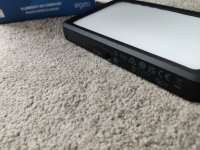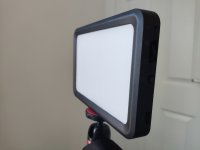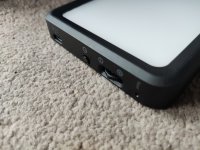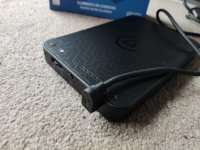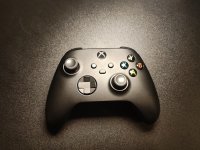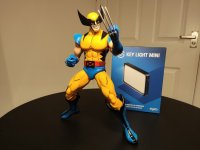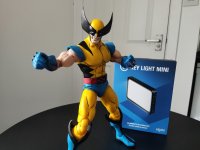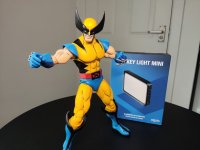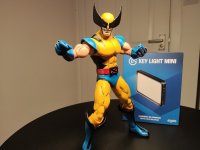 Elgato Key Light Mini (Hardware)
Elgato Key Light Mini (Hardware)
Official GBAtemp Review
Product Information:
- Official Store: https://www.elgato.com/en/key-light-mini
If the COVID-19 pandemic has clarified anything, it’s that video streaming isn’t going away any time soon; whether it’s for work or play. Zoom, Twitch and Teams are being expected options to hold meetings, events, online gaming parties and simple chats even as pandemic restrictions start to ease. This is mostly because of the convenience and relatively lower costs of holding events online as well as slashing the distance barrier.
So we will likely continue to be interacting online regularly and when it comes to showing up on video, you might want to look good. This will depend on a number of factors from the camera you use to external lighting. The latter can significantly improve the quality of an image/video for the receiving end and might be worth investing in if you’re looking to step up the quality of your video streams.
Elgato has made a name for itself in the game streaming sphere and has expanded its repertoire to include further accessories. One of the latest is the Key Light Mini, a compact, portable external light source.
Priced at £90 / $100, you will find the following items out of the box:
- Key Light Mini
- USB-C to USB-A Cable
- Quick Start Guide
As for the specs details, you can find them below:
- Brightness: 800 lumens, adjustable
- Colour range: 2900 - 7000 K, adjustable CRI > 94 %
- Battery: 3.7 V, 4000 mAh LiPo
- Charging: USB-C, fast charge up to 3 A, 5 V
- Power consumption: Maximum 15 W
- Dimensions: 147 x 100 x 17 mm / 5.79 x 3.93 x 0.67 in
- Weight: 300 g / 0.66 lbs
- Wi-Fi: 2.4 GHz / 5 GHz, 802.11 a/b/g/n
- Supported encryption: WPA2 + AES, WPA + TKIP/AES
- Mount compatibility: Elgato Multi Mount , Any mount with a 1/4-inch screw or adapter
As its name suggests, the Key Light Mini is mini, pocketable even. It somewhat bears a resemblance to a (chunky) e-reader with a quality, sturdy build with a matte black. I particularly appreciated the design at the back of the device, bearing an embossed pattern surrounding the Elgato logo.
On the underside of the Key Light Mini is a standard ¼ inch thread that enables you to securely mount the light source to a camera, tripod or any standard mount. It’s a bummer that one isn’t included in the package, especially considering the rather premium asking price.
Turning our attention to the right side of the device, we can see a USB-C port for charging/powering the Key Light Mini, a power button, a control wheel and a recessed reset button. And that’s about it for the physical controls; and, honestly, this minimalist approach works great for the device. Most controls can be handled on the device itself with ease and minimal confusion. I say minimal because it takes a few tries to get the ropes of adjusting the colour temperatures with the control wheel (how to switch between warm and cool white)
Controls are easier and more straightforward via the dedicated Control Centre software. With the latter, you can update the firmware of the Key Light Mini as well as adjust the brightness and temperature of the Key Light Mini. You can also use the physical controls and you’ll see the adjustments being mirrored in the app.
Connecting to the Control Centre app is done over WiFi but the Key Light Mini can also pair over a wired connection and you can bypass the battery with the app’s Studio Mode to power the device only via USB and save the built-in battery’s life. It’s really great to have such options that allow for more use cases and prevent a wire-fest like the CameraReady LiteBars do.
In fact, the Key Light Mini seems to have been designed to allow for more freedom of use cases. Its compact form factor enables the user to take it practically anywhere. Its 4000 mAh internal battery supports this practicality as it will provide enough juice to hold up to 4 hours (of course, subject to brightness level). Mount it on a camera for your vlog or a tripod for your video calls or just hold it with your hand to take well-lit pictures of a new device that you’d like to share on Instagram. These are all easily done with the Key Light Mini and it works great at that.
In my case, I found it not only a handy solution to improve the lighting whenever I'm on video calls but also very useful to illuminate pictures of devices for my reviews, especially at night or in poor lighting conditions. The Key Light Mini really helps heaps when doing close-up shots and provides a uniform, portable lighting source in these situations.
Even if it is small, it delivers bright lighting with its 800-lumen output. The maximum intensity is so bright that I haven’t found a use for it yet. Such extremes can be distracting and slightly blinding but toning it down easily fixes the issue. The intensity can in fact be adjusted across a spectrum which is another neat feature over having fixed intensities as you can find a sweet spot for proper illumination and not being distracting.
Moreover, you can easily switch between warm and cool white across the 2900 - 7000 K colour range to suit your preferences. The pictures below will help provide an idea about how the lighting’s effect.
As such, the Key Light Mini is really a device that allows for a range of customisation and versatility to suit the user’s needs.
While it’s a great accessory, the size and shape of the Key Light Mini, even if it delivers bright lighting, means that it might not deliver uniform lighting as a ring light would. It will shine from an angle and you’ll want to adjust that accordingly to avoid shadows and missed features in your stream/pictures. Alternatively, you might want to look for a second pair of Key Light Mini to address for more uniform lighting but that would mean paying double and the device is not very cheap to begin with.
What I’d mostly recommend it for is if you’re looking for a lighting solution for your stream/pictures that won’t clutter your setup. It will deliver on that while packing handy adjustments and customisation options; and at that, it will shine bright literally and figuratively.
Verdict
- Compact, versatile and bright
- Works both wired and wirelessly
- Customisation options with physical hardware and dedicated software
- No mount/tripod included in package
- Size and shape means it won’t illuminate uniformly
